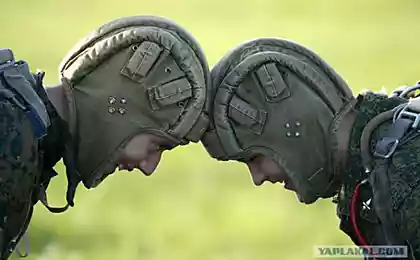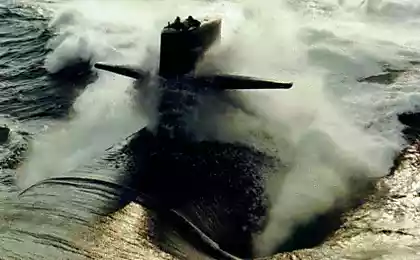1309
Gadgets and technology: civil war
Our modern world is teeming with different technologies and unusual gadgets. Internet, satellite navigation, mobile phones and thousands of other amazing technology around us. And while the vast majority of all modern high technology came into our lives from the military. After all, this area is different in that it is always necessary to be a step or even two ahead of the enemy. This means that the best minds in the first place trying to benefit the army, and then only some of the projects are developed and transferred to the real world. Today we offer to remember some of the "ex-military" technology that we use almost every day.
Internet h4>
Navigation Systems h4>
Microwave h4>
Superglue h4>
Reinforced adhesive tape h4>
Computer h4>
Oculus Rift h4>
Internet h4>
Every day, thousands of users around the world are connected to the Internet. No joke, but the idea is to create a worldwide network was born in 1957. The reason was the Soviet Union's launch of Sputnik. It was during the Cold War, so it is logical in the US have decided that the country needs a reliable system of data exchange in case of war. Develop such a network will offer not unknown Agency Defense Advanced Research Projects US (DARPA). Create it commissioned University of California, Los Angeles, Stanford Research Center, University of Utah and the University of California at Santa Barbara.
Network called ARPANET, and then by 1969 it united all 4 Institute. This year is considered to be the birthday of the Internet. After a 69-year network began to grow very rapidly and more and more scientists and US universities have begun to connect to the network. By 1971, established the first program for sending e-mail, with it immediately became very popular. International same network began only in 1973, when dialing via a transatlantic cable was connected to the United Kingdom and Norway.
Then in the "web" was a lot of stages of development. This creation of domain names, and the IRC-channel, and the rivalry with the ARPANET NFSNET, moreover to the last in the end and passed the title of "the Internet." To date, millions of people are connected to the global network and use its resources daily. But if the US did not want to get ahead of the Soviet Union in the arms race, then who knows, we might now so simply watch YouTube or email friends in Facebook.
Navigation Systems h4>
Another system, the creation of which has pushed the launch of our satellite, is, of course, the navigation system GPS. The fact is that American scientists led by R. Kershner observed signal coming from the Soviet satellite and found that due to the Doppler effect, the frequency of the received signal increases as the satellite and decreases with its distance. The essence of the discovery is that if you know exactly their position in the world, it becomes possible to measure the position and velocity of the satellite, and vice versa, knowing the position of the satellite, you can define your own speed and position.
In the Soviet Union from 1964 developed the theory of positioning, which are formulated on the basis of the requirements for the construction of navigation by satellites. The first satellite global positioning system (hereinafter GLONASS) was launched in 1982. But in a "rebuilding" system was abandoned and only appearance GPS convince everyone that needs its own system.
In 1973, the program has been initiated DNSS, later renamed Navstar-GPS, and then, in the GPS. In 1983 he began intensive work to create GPS, as the last of all the 24 satellites required for complete coverage of the earth's surface, was launched in 1993, and embarked on the GPS service. It became possible to use it for precision-guided missiles at fixed, and then on the moving objects in the air and on the ground. GPS was designed specifically for the military. However, after the Korean Airlines plane accidentally violated Soviet airspace and was shot down by fighter, US President Ronald Reagan authorized the use of the system for civilian use worldwide. But there is a caveat: that the system can not be applied for military purposes, its accuracy was deliberately reduced.
Microwave h4>
Even such a thing as a "microwave" was developed for the military. American engineer Percy Spencer long worked with the magnetron and once remarked that he had in his pocket melted chocolate. First microwave «Radarange» as time did the company, where he worked Spencer. She was as tall as a man weighing 340 kg and more power was 3 kW. Initially, this device was necessary for the military to reheat frozen food, such as in hospitals.
Superglue h4>
Surprisingly, even such a seemingly familiar thing in life as superglue was originally in service with the military. Invented the glue in 1942 when looking for chemical composition for the production of transparent glass in optical sights. But the resulting material was very sticky and it was rejected. In the future, the soldiers using this glue sealed the wound itself during the Vietnam War
Reinforced adhesive tape h4>
Simply irreplaceable thing for every self-respecting geek, and projects in the style of « dear, I'm repaired ». This tape was developed in 1942 a division of Johnson & Johnson Corporation for sealing boxes of ammunition, so they are not leaking water. However, the soldiers quickly realized that scotch can be used for many other purposes, including for the temporary repair of equipment. Today, most people know this tape unchanged gray metallic color, but originally it had a protective green.
Computer h4>
The world began to irreversibly change (though he did not yet know) in 1945, when it was assembled the world's first computer ENIAC. Originally designed as a device for calculating firing tables for artillery shells, 27-ton "gadget" has not had time to catch war. But instead, he immediately began to be used for calculations in the program to build a thermonuclear weapon. Despite the proud title of grandparent computers, ENIAC and remained the only one of its kind, because of its imperfections like him computers are no longer created.
Oculus Rift h4>
However, technology is not always move from military life into everyday. It happens quite the opposite. An excellent example is the Oculus Rift - virtual reality glasses designed for gaming. To date, these glasses developed numerous games and applications. But in the service of the US Army, they are used to train soldiers to control warships.
This project was named ProjectBlueShark. At its heart lies not only the simulation of the remote control of the ship, but also the integration of the virtual world into the control system. Developers specially created an environment in which the person is an observer and has the ability to manage a real weapon and mechanisms calculate the location of the ship, plotting and more. This was only possible thanks to Head-mounted display and auxiliaries control virtual field.
As you can see, much of what was already familiar to us before things served to benefit the military. But the army is not squeamish Civil developments and successfully apply them in teaching, and in the battle.
Source: geektimes.ru/company/svyaznoy/blog/240492/
Path to the monopoly: How "Yandex" tries to combine the Internet
In Hungary, about to introduce a tax on Internet traffic






















